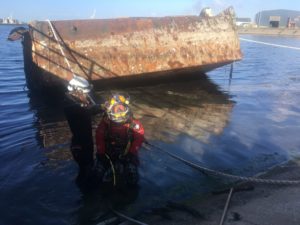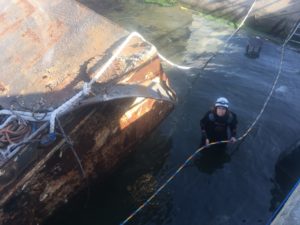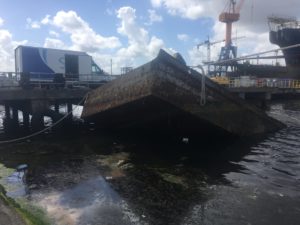At the end of World War II, a 40-ton pontoon was built to unload American equipment to drive the Germans out of the country. It was built to last as long as possible in the face of massive warfare. And it survived the war.
For many decades, the pontoon was used for all sorts of things until it was forgotten. And during a fierce storm that lasted for days, it filled up through the access hatches and sank to the bottom. For more than a year, a part of the structure stood out of the water like a monument. Then the owner decided it was time to organise a salvagion. SUBMAR was invited.
We were very proud when we were invited to establish the salvage plan. Although we have been involved in many salvage operations in the past, this was our first time to work out and present a salvage plan. After a thorough debate of a few hours with the technical management of the client, we got green light and started the preparations.
Because it was impossible to work with cranes, it was decided to bring the pontoon to the surface by means of the “inverted bucket” principle. If you turn a bucket under water upside down and blow air into it, it suddenly rises to the surface like a lifting balloon. The trick is to do this very gentl, so that the excess air can escape during the journey to the surface.
The first step, of course, was a thorough inspection of the plating to make sure the pontoon was leak-tight except for the manholes. Because of the decimetre thick vegetation, the inspection was not easy. Then we started closing the manholes with new lids and seals.
Through the covers were tubes to inject air into the pontoon and other tubes to evacuate the water. Furthermore, emergency vent holes were made in the pontoon to allow excess air to escape during the journey to the surface.
After a few days, all preparations were made and we started the air injection. The first crucial moment was the release from the bottom. Very slowly, the pontoon crawled out of the bottom and slid over 2 metres in height. Then it started to tip over until the battered front end was sticking out of the water and everyone realised that the salvage operation had been a great success.
The manholes were opened and the remaining water was pumped out. Now our divers could safely inspect the bottom plate of the pontoon. They found a hole that was clearly caused by a large impact from the inside. What had happened during that night of stormy weather? No one will ever know exactly. The divers could not find any holes in the hull caused by corrosion or loose welding after more than 75 years.
The craftsmen of the past were tough guys!
Another satisfied customer!




